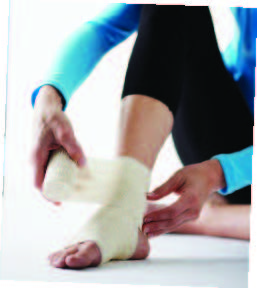News, views and insights on maintaining a healthy edge.
 They Do More Than Play Football at LSU
They Do More Than Play Football at LSU
The health benefits of dark chocolate have been shown in study after study. Thanks to researchers at Louisiana State University, we now understand why. The good microbes in our colon, specifically Bifidobacterium and lactic acid bacteria, love the chocolate compounds that our bodies are unable to break down. As they digest the cocoa fibers, they produce new compounds that are able to be absorbed by our bodies. These compounds lessen the inflammation of cardiovascular tissue.
 The Five-Second Rule: A Second Look
The Five-Second Rule: A Second Look
Is it okay to consume food dropped on the floor if it’s picked up within five seconds? A team of British biology students have the answer to this question: It depends on the food…and the floor. The study, conducted at Aston University, measured the transfer of bacteria—specifically E. coli and Staphylococcus—on a variety of foods dropped on a variety of flooring for between 3 and 30 seconds. Wet and sticky food, such as noodles and candy, attracted the most bacteria. Carpeting proved to be “safer” (if you don’t mind the fibers and grit) than tile and laminate flooring. Not surprisingly, the longer food stayed on the floor, the more bacteria it attracted. In other words, you’re much better off plucking a chip off the carpet than consuming a chicken leg that tumbled off the kitchen counter.
 Surprising Findings in Oral Cancer Study
Surprising Findings in Oral Cancer Study
A joint study conducted by researchers in Germany and Scotland looked at the relationship between oral health behavior and the risk of developing cancers of the mouth and throat. Nearly 4,000 individuals were involved in the study. The results, published in Oral Oncology, turned up one really surprising piece of information. Heavy users of mouthwash—for example, three times a day—appeared to have a higher risk of cancer than those who brushed regularly but used mouthwash infrequently or not at all. The research team did not analyze the types of mouthwashes being used, and stated that this finding required further research. Another interesting conclusion the study drew was that denture wearers were at the same risk of developing serious oral problems as non-denture wearers if they did not schedule regular dental office visits. “Over the years, a number of studies such as this one have suggested that there may be a correlation between excessive use of mouthwash and the development of cancers of the mouth and throat,”

Barry Levinson, MD
Medical Director, Trinitas Comprehensive Cancer Center 908.994.8772
Barry Levinson, MD, Medical Director of the Trinitas Comprehensive Cancer Center points out. “It appears that the number of patients in this study who fell into the category of excessive users of mouthwash did not present enough statistical significance for the study to lend any strong support to drawing a connection to cancers of the mouth and throat. Smoking, drinking, and overall poor oral hygiene are much more important factors that lead to the development of oral cancer.”
 Home Games
Home Games
When we think of common musculoskeletal injuries, we tend to picture weekend warriors writhing in pain with fractures and tears suffered on a court or playing field. The truth is that about half of all musculoskeletal injuries occur at home. Sprains, strains and other soft-tissue injuries are actually the most common musculoskeletal injuries. They can cause a significant amount of pain, dysfunction, and disability and are also a major source of time missed from work, school, and recreation—which burdens both the individual and the healthcare system. According to

Christopher R. Ropiak, MD Union County Orthopaedic Group 908.486.1111
Dr. Christopher Ropiak of the Union County Orthopedic Group, many of the more common home-based injuries occur due to repetitive motion or significant straining in the setting of poorly conditioned or underprepared muscles. Consequently, many injuries might be prevented by routine and regular fitness programs, especially those that focus on core muscle strength and functional movements. “Even among people that do exercise regularly, too many of us focus on exercises that do not translate well into everyday life,” Dr. Ropiak points out. “While there are some benefits to body building or long hours on the elliptical machine, these types of exercises are often not very helpful in avoiding common injuries like back strains, muscle tears, etc.” Going to a gym or a trainer is great but for many of us, he adds, due to time and money constraints, that is just not a realistic option for everyone. Dr. Ropiak encourages his patients to explore some of the home-exercise programs that require a fraction of the time and money that it takes to go to the gym…“and might keep you out of the doctor’s office.”
 Number One Not So Fun
Number One Not So Fun
Time to break out the “purple dye”…it turns out that peeing in the pool can actually create a significant health hazard. New findings from a study at Purdue University confirm that uric acid, when mixed with common pool chemicals (including chlorine), can actually create dangerous compounds—including called cyanogen chloride, which is toxic to organs when inhaled, and trichloramine, which can injure the lungs. “Parents need to educate themselves—as well as their children—about public health and safety issues,” says

Kevin Lukenda, MD
Chairman of Family Medicine, Trinitas Regional Medical Center 908.925.9309
Dr. Kevin Lukenda, Chairman of Family Medicine at Trinitas. “They should stress the basics of hygiene: the importance of frequent hand-washing and sanitizing, the proper handling of paper money, shared cell phone use, and of course, ‘peeing in the pool.’ All are potential health risks that can be avoided through proper education.” Urinating in the pool is controllable behavior but we all know people do it anyway assuming it’s harmless. Well, it’s not. Who are the worst offenders? Competitive swimmers. P.S. They don’t fall for the old purple dye trick.





